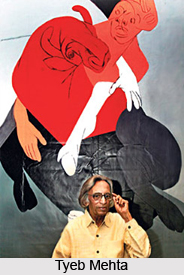 Tyeb Mehta was born in 1925, in Gujarat, India. He started his career as a film director. Later his passion for arts led him to Sir J.J. School of Art, Mumbai, from where he completed his graduation in 1952. After that, he left for London and Paris for four months. On his return to India, he conducted his first solo exhibition of drawings, paintings and sculptures in 1959 at the Jehangir Art Gallery, Bombay. He lived and worked in London from 1959 to 1964. Afterwards he visited US in 1968 on a Rockefeller Fund Scholarship. He was a multifaceted persona.
Tyeb Mehta was born in 1925, in Gujarat, India. He started his career as a film director. Later his passion for arts led him to Sir J.J. School of Art, Mumbai, from where he completed his graduation in 1952. After that, he left for London and Paris for four months. On his return to India, he conducted his first solo exhibition of drawings, paintings and sculptures in 1959 at the Jehangir Art Gallery, Bombay. He lived and worked in London from 1959 to 1964. Afterwards he visited US in 1968 on a Rockefeller Fund Scholarship. He was a multifaceted persona.
Mehta resembles other artists of the Progressive Artists Movement in India. He traces back his work to the European masters. His works were inspired from the macabre deformation used by artists like Francis Bacon. He learnt pictorial language of European art during the 1950s and `60s and after coming back to India, he attempted to blend the fundamentals of that art form with the `Indian` themes and subjects throughout the `70s and `80s. Mehta had nailed down his search for the eternal in the composite, from painting rickshaw-wallahs to a tied up bull, to layered images and conceptions of Hindu mythology. The 90s experienced his imagination in the form of myth of the Goddess - as Durga, Kali, Mahishasura Mardini and different incarnations of the goddess.
While creating multiple images he uses the ancient Indian technique in order to convey motion. This is seen in cases of the Nataraja who has many arms. The arm interprets the movement of the hands in the Bharatnatyam dance form. He attempted to intermingle this with the revolutionary vision that he had developed during his days as a member of the Bombay Progressive Artists Group. Mehta uses this olden Indian handling of movement to reproduce the persisting down slope in the price of a man`s work in today`s world of soaring prices of other commodities. The ancient images are portrayed in modern sense through his paintings.
Among his most noted later paintings were his triptych Celebration, which was sold for Rs 1.5 crore at a Christie`s auction in 2002. This was the highest sum paid for an Indian painting at an international auction. His other noted works were the `Diagonal Series`, Shantiniketan triptych series, Kali, Mahishasura.
Tyeb Mehta spent most of life in Mumbai and later in life stayed at Lokhandwala, Mumbai. He died on 2 July 2009.
Awards Received by Tyeb Mehta:
He received the Rockefeller Fellowship in 1968. In the same year he received a gold medal for painting at the first Triennial in New Delhi, and in 1974 the Prix Nationale at the International Festival of Painting in Cagnes-sur-Mer, France. He also received the Kalidas Samman which was instituted by the Madhya Pradesh Government in 1988. The Dayawati Modi Foundation Award for Art, Culture, and Education in 2005 was also received by him. He has also been the recipient of the Padma Bhushan in 2007.



















